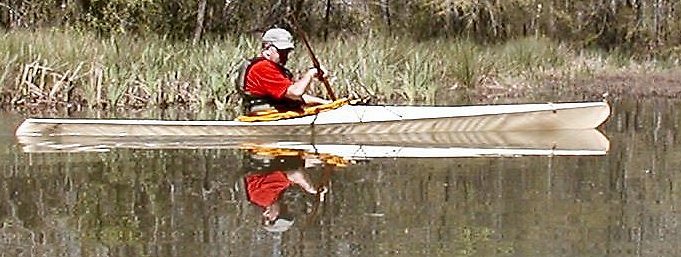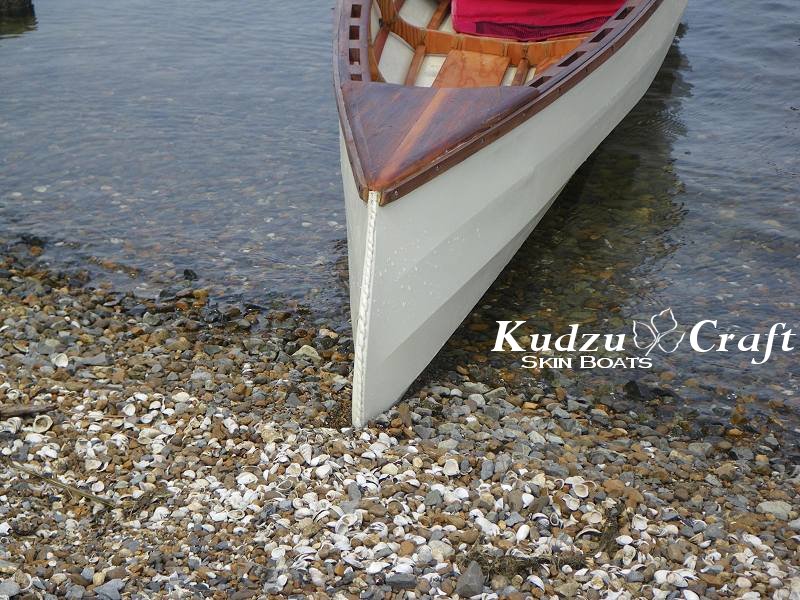WHICH FABRIC SHOULD I SKIN MY BOAT WITH?
First let me say there is no perfect skinning material. One of the problems is that there is nothing made specifically for our application. All the fabrics we use are intended for some other use. Someone has been willing to experiment and found fabrics that work, some better than others.
Some people use a coated fabric that is used for truck tarps. It works but I don’t care for it. Canvas is another good fabric but it is harder to work with and being a natural fabric it will rot so it needs extra care. You will see photos of kayak covered in clear vinyl, while this make s a great looking boat be warned, it is not durable! Once it punctures it will tear easily. It looks great but it not practical choice.
Nylon is the most used fabric but probably 95% of my clients skin my boats with polyester. Both fabrics make good skins but they have different characteristics and skinning methods that will influence your choice.
NYLON
As I said, nylon is the most popular fabric. It stretches a lot before it breaks, it’s durable and will not puncture easy. Very few coatings will stick to nylon so your choices for waterproofing are limited.
Of course nylon is not perfect. It has one drawback that I find very annoying. Nylon is hygroscopic, meaning it absorbs water. When nylon gets wet it expands or relaxes. That means your drum tight skin you worked so hard to sew on will become baggy when you hit the water the first time. If you look at this picture, this was the 2nd or 3rd trip I made in my Curlew.

The shadows you see on the skin are from wrinkles where the fabric relaxed. Yes, it started out drum tight and it loosened up this much. The good news is it got better with age.

This was taken 6 months or so latter. Notice there isn’t even a hint of a wrinkle but it has loosed up. David had paddled this one for about 3 hours when this photo was taken. He never noticed the skin had loosened till I pointed it out once the boat was on my trailer but it was slightly loose around the frame.
This boat was skinned with a 12 oz nylon. I used a 7 oz nylon on a Long Shot and it always looked baggy and wrinkled even after a year of heavy use. So some fabrics are obviously worse than others.
POLYESTER (sometimes called DACRON)
Unlike nylon, polyester doesn’t absorb water and relax or wrinkle when wet which is one of the big reasons I swapped to polyester. I just couldn’t build someone a boat and have it wrinkle up first time they used it.
Polyesters biggest advantage is that most any coating will adhere to it, including water based coatings. With so many states outlawing oil based finishes that is an important consideration.
Polyester drawbacks are that it doesn’t stretch like nylon so it will not take abuse as well as nylon. BUT that doesn’t mean it is not more than strong enough. I have built and paddle skin boats for many years and I have never put a hole in polyester boat under normal use. You can run over limbs, trash and rocks with nothing but a scratch. Just don’t try it on white water! That will ruin one of either fabric quickly.
The 8 oz. fabric we offer is a looser weave and you use a different method to sew it on than you do nylon. Traditionally it has been sewn on loose and then heat applied to shrink it. I have developed a method for sewing it on tight that I recommend using over shrinking it on the boat.
AIRCRAFT POLYESTER
You will see people recommend aircraft fabric for SOF boats. It is very similar to what we sell, has excellent shrinkage but it is very lightweight fabric. What we recommend is almost 3 times as heavy as typical Aircraft fabric. Many people have used the Aircraft fabric and it does work but you really need to be careful because it is not nearly as durable and wearing through or even putting a hole in it is much more likely. That is why I do not recommend it.
Confused? Don’t feel bad, everyone is at first, it just not an easy choice. After using different fabrics I now recommend the polyester to a new builders. I have developed a method for sewing on the polyester and created a set of videos to walk you through the process.
My favorite thing about polyester is that you can use most anything on it to waterproof the fabric. My favorite finish is oil base paint. It’s a reasonably tough finish and it is easy to touch up if you need. Plus you can get creative with it if you have the skills. It takes a different technique to sew the polyester on because it doesn’t stretch. I made a set of videos showing my methods for sewing a polyester skin.





